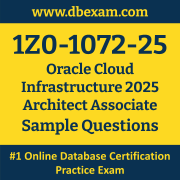01. OCI compartment quotas have three quota policy statements: Set, Unset, and Zero. Which statement removes all access to a specific resource type within a compartment?
a) Set
b) Unset
c) Zero
d) All statements have the same effect.
02. Which two are valid retention rule types in Oracle Cloud Infrastructure (OCI) Object Storage?
a) Time-bound
b) Unlimited
c) Indefinite
d) Duration-bound
03. In OCI IAM, which authentication method enables compute instances to access resources securely without storing credentials directly?
a) API keys
b) Federated Identity
c) OAuth 2.0 tokens
d) Instance Principal
04. Examine this policy: Allow group GroupMgr to manage volumes in tenancy where request.permission != 'VOLUME_DELETE'
Which three actions can a user belonging to the GroupMgr group perform?
a) Create volumes.
b) Update volumes.
c) Move volumes.
d) Delete volumes.
05. Your application or workload includes big data, analytics, media processing, or content management. You require Portable Operating System Interface (POSIX)-compliant file system access semantics and concurrently accessible storage. Which storage service must you use?
a) Vault Storage
b) Block Storage
c) Object Storage
d) File Storage
06. Which two statements are true about boot volumes?
a) You can delete the boot volume that is currently attached to an instance.
b) You can detach a boot volume from a running instance.
c) You can launch another instance by using an unused boot volume.
d) You can create a backup of boot volumes.
07. For maximum cost efficiency, when launching compute instances, which capacity type must you select for workloads that run periodically or for short periods of time and don’t require continuous availability?
a) On-demand capacity
b) Pre-emptible capacity
c) Reserved capacity
d) Dedicated capacity
08. Which four layers of access control are used by the File Storage service?
a) Oracle Cloud Infrastructure (OCI) policy
b) Network security
c) NFS export option
d) NFS v.3 UNIX security
e) Key management
f) Web application firewall
09. An organization plans to create an identity domain in the US East (Ashburn) region for a development team. However, some developers might occasionally need access to resources in the Germany (Frankfurt) region. How can OCI IAM be configured to facilitate such cross-region access?
a) No additional configuration is needed; users can access resources in all regions by default.
b) The identity domain automatically replicates to the Germany (Frankfurt) region.
c) The administrator can grant users permissions to access specific resources in the Germany (Frankfurt) region.
d) Identity domain replication must be enabled for the development domain to allow access to other regions.
10. Which two statements are true about site-to-site VPN?
a) It provides a site-to-site IPSec connection between your on-premises network and your virtual cloud network (VCN).
b) It encrypts IP traffic before the packets are transferred from the source to the destination and decrypts the traffic when it arrives.
c) You cannot use multiple site-to-site connections between your on-premises network and virtual cloud network (VCN).
d) The communication between the source and destination sites is unencrypted.
 The Oracle Cloud Infrastructure Architect Associate (1Z0-1072-25) Sample Question Set is designed to help you prepare for the Oracle Cloud Infrastructure 2025 Certified Architect Associate certification exam. To become familiar with the actual Oracle Certification exam environment, we suggest you try our Sample Oracle 1Z0-1072-25 Certification Practice Exam.
The Oracle Cloud Infrastructure Architect Associate (1Z0-1072-25) Sample Question Set is designed to help you prepare for the Oracle Cloud Infrastructure 2025 Certified Architect Associate certification exam. To become familiar with the actual Oracle Certification exam environment, we suggest you try our Sample Oracle 1Z0-1072-25 Certification Practice Exam.